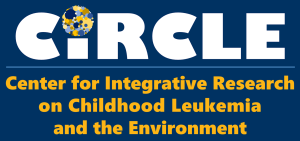Americans typically spend about 90% of their time indoors and children, in particular, spend much of that time at home. There are many potential sources of chemicals inside most homes. For example, a puff of cigarette smoke contains polycyclic aromatic hydrocarbons (“PAHs”), an upholstered couch can contain flame retardants such as polybrominated diphenyl ethers (“PBDEs”), and a wood floor finish from the 1960s might contain polychlorinated biphenyls (“PCBs”). Certain chemicals found at home may be harmful to children. As such, CIRCLE investigators have devoted a lot of effort to measuring pollutants that can be found inside a home and in examining how these pollutants might impact the risk of developing leukemia.
WHAT IS A RISK FACTOR?
Below are a few examples of some risk factors for childhood leukemia that can be found in the home. Based on what is known today, CIRCLE investigators believe that when children are exposed to one of these risk factors at critical periods during their lives, the likelihood of developing childhood leukemia increases by a small amount. Some familiar examples of risk factors for other diseases include cigarette smoking for lung cancer or high blood pressure for heart disease. Of course, not everyone who smokes gets lung cancer and not everyone with high blood pressure gets heart disease. Similarly, a child exposed to any of the risk factors listed below does NOT necessarily end up with leukemia. In fact, because childhood leukemia is rare, it’s very unlikely that any single child exposed to these risk factors would develop leukemia. Moreover, because there are many risk factors for childhood leukemia, it is not usually possible to identify the specific cause of an individual child’s disease. Still, it is helpful to recognize childhood leukemia risk factors, so that efforts can be made to avoid exposing children to these potentially harmful agents.
A risk factor is any attribute, characteristic or exposure of an individual that increases the likelihood of developing a disease or injury.
-The World Health Organization
RISK FACTORS FOR LEUKEMIA IN THE HOME
Exposure to a variety of common household agents may increase a child’s risk for leukemia. Some examples of potential risk factors for childhood leukemia that can be found in the home are illustrated below. Click ONCE on any room in the home to see a household exposure related to childhood leukemia. Click AGAIN on any room to find out more information about the risk factor featured.


